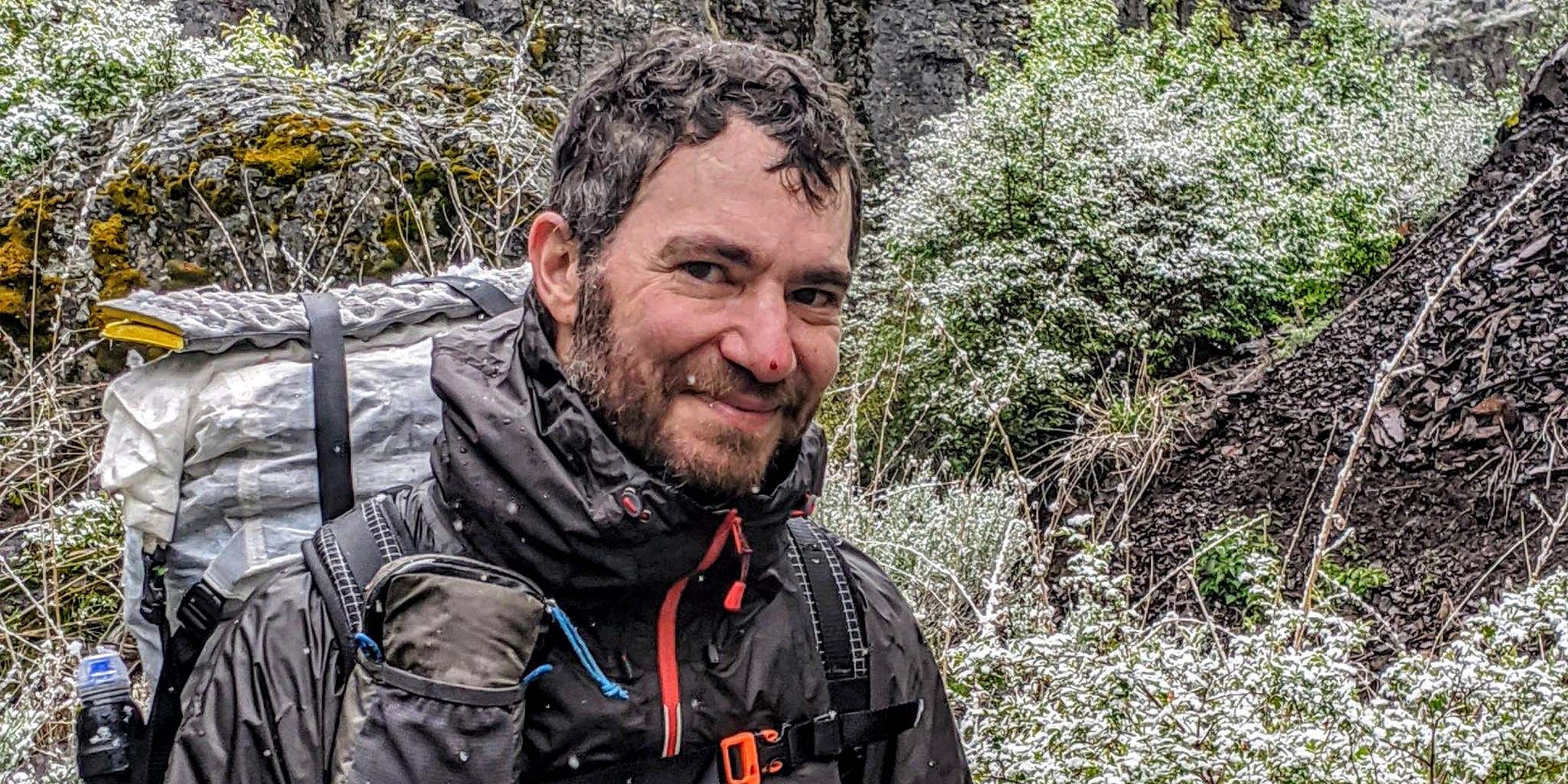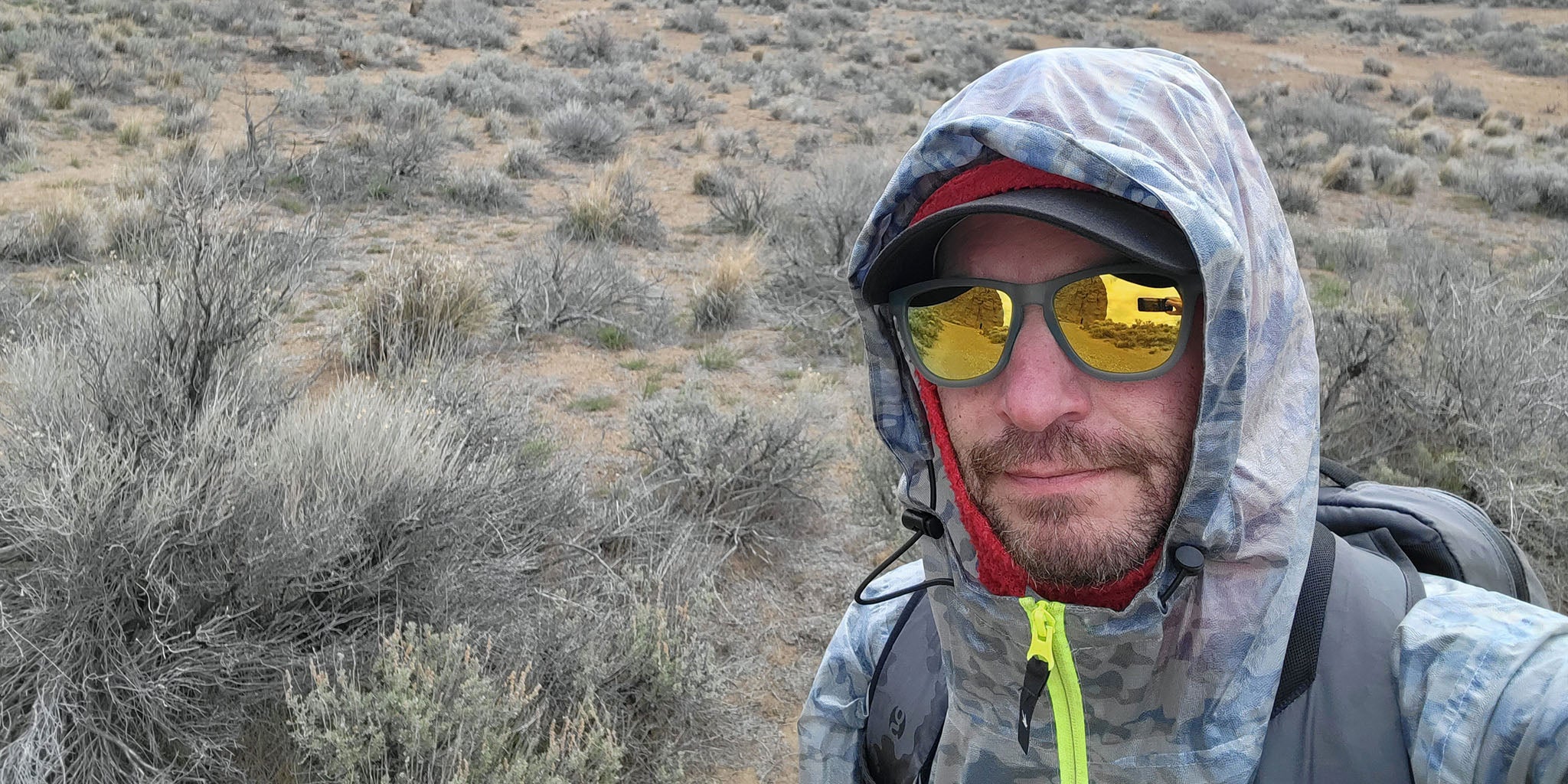Words and Photos from Scott Nechemias
The vast majority of my shoulder and winter season hiking takes place in the Oregon High Desert and Great Basin. This unique climate can throw so many different kinds of weather at you that my partner and I have invented a couple of terms to better express the atmospheric all-you-can-eat buffet consumed when hiking this region.
Slain: A form of precipitation not quite rising to the traditional level of sleet.
Snail: A form of precipitation not quite rising to the traditional level of hail.
These compliment the more commonly known hail, sleet, rain, and snow, which would be enough to be getting on with–BUT WAIT, THERE'S MORE! Hikers can also expect to experience high winds, extreme oscillations between day and night temperatures, cloying mud after snowmelt, and fabric shredding vegetation. From October to May, you can experience temperatures as low as 15 one day to as high as 70 the next.
 ▴ From sun to blizzard faster than a Dairy Queen drive thru. The Death Trap in the Oregon Canyon Mountains. Not a typo, it’s labeled Death Trap on the USGS.
▴ From sun to blizzard faster than a Dairy Queen drive thru. The Death Trap in the Oregon Canyon Mountains. Not a typo, it’s labeled Death Trap on the USGS.
Sound like a good time? It can be with the right layering system to keep your temperature regulated on the move and in camp. I’ll start by identifying the components of a layering system familiar to most and then detail how to best use them in this challenging environment. We’ll go from the top to the bottom on the human body. My personal choices are indicated below by FDR MODE (Full Desert Rat Mode).
 ▴ Bloody nose from stickers is optional but recommended. Montbell Versalite Jacket with Patagonia R1 fleece, Tilley Wanderer Hat.
▴ Bloody nose from stickers is optional but recommended. Montbell Versalite Jacket with Patagonia R1 fleece, Tilley Wanderer Hat.
HAT: A baseball cap is fine, but I’d pair it with a balaclava or buff for more warmth and sun protection. A wider brim hat offers more sun protection, a bit more shelter from driving precipitation, and lets everyone know you’re confident enough to own the “Indiana Jones goes to the farmer’s market in his Subaru” look.
→ FDR MODE: Tilley LTM6 paired with detachable cape
HIKING SHIRT: Button up or quarter zip long sleeve, synthetic quick drying.
→ FDR MODE: Columbia Silveridge button-up
MITTS: Rain mitts are light and a lifesaver, especially considering the terrain often requires active use of trekking poles, exposing your hands to cold rain, or slain, or snail, or sleet, or–you get the idea. Available from companies like Mountain Laurel Designs or REI.
→ FDR MODE: REI GTX Mitts
SHELL: There are a ton of options here, but I’ll discuss two different categories, breathable and non-breathable. Breathables would include jackets like the Patagonia Torrentshell or Montbell Versalite. These jackets will allow for more high-intensity hiking before getting soaked in your own sweat but may become more easily overwhelmed in high-intensity, long-duration precipitation and will be slightly more fragile than non-breathable options like a Frog Toggs Xtreme Lite Jacket, which is not breathable in any meaningful way but will essentially shake dry. You might decide on which is best for you in conjunction with your:
FLEECE: This is your moving mid-layer. In conjunction with the above, if you were to choose a less breathable shell, then I would go with a lighter mid-layer, examples being a Senchi Alpha Fleece, Mountain Hardwear Airmesh, or KUIU Peleton. A more substantial traditional fleece made with 100 weight or higher Polartech will handle wind better without a shell, and I find they pair better with the breathable jackets than the lighter fleece mid-layers.
→ FDR MODE: Montbell Versalite and Mountain Hardwear AirMesh Hoodie
 ▴ Non-breathable Frogg Toggs Extremelight paired with Alpha Fleece.
▴ Non-breathable Frogg Toggs Extremelight paired with Alpha Fleece.
WINDSHIRT: Not applicable to this environment due to the low durability of fabrics and wallet busting nature of the vegetation.
STATIONARY MID-LAYER: Your typical three season backpacking puffy with near to 3oz of down or more will be fine, or a synthetic like the Enlightened Equipment Torrid Jacket.
→ FDR MODE: Enlightened Equipment Torrid Jacket
 ▴ Enlightened Equipment Torrid Jacket, kept at the top of a pack liner for quick access at a chilly break spot.
▴ Enlightened Equipment Torrid Jacket, kept at the top of a pack liner for quick access at a chilly break spot.
PANTS: Here the balance is durability and drying fast. Good options include Prana Stretch Zions, OR Ferrosi, and Wrangler Men’s Flex Outdoor Cargo Pants.
→ FDR MODE: Wrangle Flex
RAIN PANTS: Consider them based on the forecast but know that they are going to take a beating in this environment and the service life will not live up to typical backpacking use.
→ FDR MODE: We don’t need no stinking rain pants.
SUN HOODY, WIND PANTS and RUNNING SHORTS: Don’t do this in the high desert shoulder season and winter unless you like spending money, being cold, and cutting up your legs. I understand this the present treasured thru hiker image, but we’re not thru hiking right now, this isn’t Instagram, and we’re in FULL DESERT RAT MODE.
 ▴ This ain’t August on the PCT, so don’t dress like a Trek Article. Patagonia Torrentshell with Montbell Versalite Pants, Dry Creek Canyon Wilderness Study Area, Oregon.
▴ This ain’t August on the PCT, so don’t dress like a Trek Article. Patagonia Torrentshell with Montbell Versalite Pants, Dry Creek Canyon Wilderness Study Area, Oregon.
OK BUT WIND PANTS: Can be pretty nice to have in camp if your pants are wet at the end of the day, giving you something dry to get your legs in for a 2oz penalty, maybe even in your quilt if you need a little bump of warmth.
→ FDR MODE: Montbell Tachyon
Listed above is a smorgasbord of ultralight gear that will best serve as fuel for a signal fire if you don’t use it correctly. The key principle here is to not let any of your insulated layers become unduly saturated with moisture, either from your body or from the sky.
I’ve found the biggest obstacle is simply laziness or impatience. Let’s take a typical January morning on the Columbia Plateau as an example. The temps are in the mid-thirties, there is a blustery wind, and I don’t have much climbing to do right at the start of the morning, so I might start hiking with my fleece, puffy, and shell on because I’m cold getting out of my quilt. The moment I start climbing and the exertion level goes up, layers need to keep coming off accordingly to prevent soaking myself as much as possible. This means taking breaks to maintain your layers. Life will go on if you don’t set an FKT, it won’t go on if you soak your insulation in an uncaring isolated environment.
The adjacent skill here is organizing your pack to allow for quick access to your layering system. Consider putting your shell and rain mitts in external easy to access pockets. I usually keep my fleece under the top strap of my backpack, and sometimes bringing an extra oven bag to stuff it in if I want to keep it out but it’s sprinkling, or too warm to wear a fleece under my shell. I keep my puffy, which I almost never use during daytime, at the top of my pack liner during breaks.
 ▴ January atop the John Day River Canyon, Mountain Hardwear Microchill Fleece with Prana Stretch Pants. American Flag Bandana serves as bullet repellent near public land boundaries.
▴ January atop the John Day River Canyon, Mountain Hardwear Microchill Fleece with Prana Stretch Pants. American Flag Bandana serves as bullet repellent near public land boundaries.
These methods are good practice for any environment but are especially important in places like the high desert with large temperature swings and extreme weather. If there is something distinct about the list of gear above I’d say maybe there is a bit more of it than you might find on a modern six or seven pound base weight pack list, the included categories above are likely to push you more towards nine. But, you can still be a FULL DESERT RAT and be ultralight if you’re willing to forego some reddit and Instagram likes and embrace a less fashionable but more utilitarian approach.
 ▴ Spring Basin Wilderness, Oregon.
▴ Spring Basin Wilderness, Oregon.
Based in Portland, Oregon, Scott takes wilderness backpacking trips primarily in the Pacific Northwest, but often other parts of the mountain west and abroad. He has a particular affinity for off-trail travel, the high desert, and the places in the world less traveled by people. You can find more of his trips at www.alongthewaypoints.com and on Instagram.























